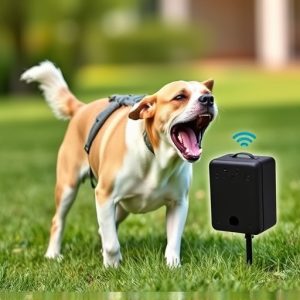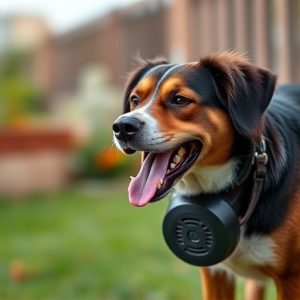Sonic Dog Training: Effectiveness, Safety, and Best Practices
Sonic dog training utilizes non-invasive devices like sonic collars to emit high-frequency sounds th…….
Sonic dog training utilizes non-invasive devices like sonic collars to emit high-frequency sounds that condition dogs to alter behavior, such as barking or jumping. Dog Repellent Device Compliance Testing is essential to ensure these tools meet safety and performance standards, including frequency, decibel level, and activation range. Rigorous testing verifies effectiveness, mitigates false activations, and confirms no lasting harm. Best practices for sonic dog training include adhering to local regulations, understanding canine sensitivity, using positive reinforcement, establishing routines, and monitoring reactions during sessions.
“Unleash a new, effective approach to canine training with sonic dog training and behavioral correction techniques. This comprehensive guide explores the power of sound in modifying pet behavior. From understanding the core principles behind sonic training to uncovering the role of dog repellent devices and their impact on compliance testing, we demystify this modern method. Learn best practices for implementation, ensuring safety and effectiveness. Discover how this innovative strategy can transform your dog’s obedience journey.”
- Understanding Sonic Dog Training and Its Principles
- The Role of Dog Repellent Devices in Behavioral Correction
- Conducting Compliance Testing for Effectiveness and Safety
- Best Practices for Implementing Sonic Training Techniques
Understanding Sonic Dog Training and Its Principles
Sonic dog training is an innovative behavioral modification technique that uses sound waves to correct unwanted behaviors in canines. This non-invasive approach involves the use of a dog repellent device, often called a sonic collar or ultrasonic trainer, which emits high-frequency sounds imperceptible to humans but irritating to dogs. The principle behind this method is not punishment but rather conditioning; by pairing specific actions with an unpleasant (but safe) sound, dogs learn to alter their behavior to avoid the stimulus.
Compliance testing is a crucial aspect of sonic dog training. These devices are designed to be effective yet safe, emitting sounds only when triggered by the pet’s unwanted behavior. Rigorous testing ensures that these tools meet specific criteria for frequency, decibel level, and activation range, ensuring they function optimally and safely in various environments. This not only guarantees a positive training experience but also aligns with legal standards for pet care products.
The Role of Dog Repellent Devices in Behavioral Correction
Dog repellent devices have emerged as a popular tool in positive reinforcement training, offering an effective solution for modifying canine behavior. These devices work by emitting sounds or vibrations that temporarily disrupt a dog’s attention, helping to prevent unwanted actions like barking, jumping, or pulling on leashes. One of the key advantages is their ability to provide immediate feedback and correction without causing physical harm, making them a humane alternative to traditional punishment methods.
Compliance testing for dog repellent devices is essential to ensure their effectiveness and safety. Rigorous testing protocols evaluate the device’s sensitivity and responsiveness, ensuring they activate only when necessary. This process also considers factors like range, durability, and reliability in various environmental conditions, allowing owners to make informed choices. By adhering to strict standards, these devices can be trusted as valuable aids in training, promoting a harmonious relationship between dogs and their handlers.
Conducting Compliance Testing for Effectiveness and Safety
To ensure the effectiveness and safety of a dog repellent device, conducting comprehensive Compliance Testing is paramount. This involves rigorous assessments to verify that the device operates as intended, emitting safe and effective signals or stimuli to correct undesirable behaviors without causing harm or discomfort to the animal. Tests should cover various aspects, including range and accuracy of signal emission, sensitivity adjustments, and durability under different environmental conditions.
Compliance testing also considers potential triggers for false activations, ensuring the device is sensitive enough to detect problematic behavior but not overly reactive to benign activities. Additionally, safety standards must be met, confirming no physical harm or lasting effects on the dog’s health, even when used consistently over time. By adhering to these rigorous protocols, Dog Repellent Device Compliance Testing guarantees that correction methods are both humane and reliable.
Best Practices for Implementing Sonic Training Techniques
When implementing sonic dog training techniques, it’s crucial to prioritize safety and effectiveness. Start by ensuring compliance with local regulations regarding pet training devices. Conduct thorough testing on various dogs to understand their individual sensitivity to sound frequencies, as what works for one may not work for another. Use positive reinforcement alongside sonic repellents to encourage desired behaviors; never use the device as punishment.
Consistency is key. Establish a clear routine and set consistent boundaries for your dog’s behavior. Regularly practice in controlled environments before introducing new stimuli. Always monitor your dog’s reaction during training sessions, stopping immediately if any signs of discomfort or fear are observed. Be patient; effective behavioral correction takes time and dedication.
Sonic dog training, leveraging behavioral correction techniques and dog repellent devices, offers a modern approach to enhancing canine conduct. By understanding the principles behind this method and adhering to best practices, including thorough compliance testing for safety and effectiveness, pet owners can harness its potential to create a well-behaved companion. Incorporating these strategies into your dog’s training regimen could be the key to unlocking a harmonious relationship, ensuring both your safety and your pup’s obedience.


